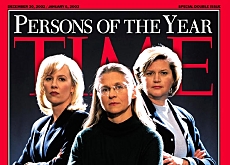Corporate profits – what are they really worth?

Swiss companies have reported a string of record results for 2004, led by banking giant UBS with stated net profit of over SFr8 billion ($6.67 billion).
The figures are enormous, but so are the incentives for managers to make them look good. So how can an investor, or an interested bystander, know whether they correspond to reality?
The question has been highlighted by the shift from Swiss accounting standards to two internationally recognised systems – IFRS and US GAAP – which became mandatory for larger firms as of January 2005.
One early changer, the Credit Suisse bank group, provided a possible taste of things to come when it changed its reported 2003 net profit from SFr5 billion under Swiss standards to just SFr770 million under the newly-adopted United States system.
The main reason? Differing accounting treatment of a 1997 acquisition, in which – with the benefit of hindsight – Credit Suisse paid well over the odds for insurance company Winterthur.
For Eric Ohlund, a partner at the Swiss branch of international accounting firm Ernst & Young, the case simply illustrates a basic truth – that financial statements are not reality, just one way of presenting it.
Change happens
“Net profit is not the amount of cash generated by a company, and it is not even the amount that could be paid in dividends to shareholders. It is simply an amount calculated according to existing accounting conventions,” Ohlund told swissinfo.
“Probably the most important lesson of accounting is that everything depends on the underlying assumptions. The figures may be volatile, but then the world they are based on is volatile.”
In the case of Credit Suisse, the discrepancy between the two ways of reporting profit and loss may seem enormous, but the underlying reality is still the same.
By way of analogy, an individual may choose to pay for a new car (or house) in cash or by staggering the payments over many years.
For companies, as for individuals, what really matters is the underlying ability to pay the bill – and the use of consistent, or at least comparable, reporting standards over time.
Ohlund says international moves to harmonise accounting standards are resulting in a gradual “levelling out” of differences, with profit figures gradually becoming more consistent between companies – and hence more comparable.
He says the clear international trend is away from the traditional accountant’s focus on the historic cost of assets (the price paid at the time of acquisition) and towards the concept of “fair value” – their estimated market value at today’s prices.
However, while this may result in more “relevant” estimates, it can also lead to far greater volatility – for instance, the large discrepancy between what Credit Suisse paid for Winterthur eight years ago and its much lower estimated value today.
Better mousetrap?
The London-based International Accounting Standards Board (IASB), has formed a working party with its counterparts in the US to analyse the pros and cons of today’s corporate performance measures.
One issue is whether net profit figures would be more reliable if the rules about which costs to charge against profit – and which to record as investment on the balance sheet – were less arbitrary.
In theory, any changes in annual profit or loss show up on the following year’s balance sheet, but companies have considerable freedom to choose how they present the results (and fewer people read the balance sheet or the financial footnotes).
Some professionals champion the idea of a new catch-all number that would take account of all gains and losses anywhere in a company’s accounts – a concept referred to as “comprehensive income”.
But many companies – and company auditors – are unimpressed, as they fear such a concept would further increase volatility, scare off investors and make it more expensive to borrow money.
Wolfgang Reichenberger, chief financial officer of Swiss-based food giant Nestlé, told the Financial Times newspaper: “I can understand that it is an academically beautiful solution, but it doesn’t say anything about real performance.
“At Nestlé, we would have billions of dollars of foreign exchange swings from assets outside Switzerland. We don’t have to tell shareholders in a performance statement that the dollar has weakened.”
Starting point
Ohlund agrees that, while there is no “magic number” that provides the whole truth about a company’s financial position, net profit is still a good starting point.
He prefers it to operational profit measures such as EBIT or EBITDA, both because the concept is more clearly defined and because it gives a better overall picture.
“If the job of management is to maximize profit, it doesn’t matter whether this comes from maximizing fair value or from maximizing operational profit – it’s the final picture, after tax and everything, that counts.”
However, he stresses that any accounting figure is important not on its own, but as part of a set of measures.
Other key measures include cash flow from operations (how much money the company is actually generating), liquidity (ability to pay bills) and gearing (the extent of dependency on borrowing).
Ohlund concludes: “It is difficult to say what is really the best measure, because they all tell you something. At the end of the day, what matters is clear conventions and consistent application.”
swissinfo, Chris Lewis in Zurich
As of January 2005, IFRS and US GAAP are the only recognised financial reporting standards on the main segment of the Swiss stock exchange (SWX).
Special provisions are made for companies based abroad and for banks.
The main differences between the two involve amortisation of goodwill, charging for employee stock options and funding of pensions.
The Swiss move to international standards shows that different ways of treating the same figures can lead to striking discrepancies.
Ohlund points out that any accounting method is just one way of presenting financial reality.
However, casual observers need not give up any attempt at comparisons – provided they remember some basic rules.

In compliance with the JTI standards
More: SWI swissinfo.ch certified by the Journalism Trust Initiative


You can find an overview of ongoing debates with our journalists here. Please join us!
If you want to start a conversation about a topic raised in this article or want to report factual errors, email us at english@swissinfo.ch.